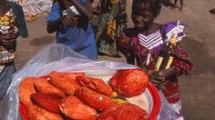Abstract
The fluorescent amplified fragment length polymorphism method (AFLP) has been successfully applied to one of the brown rot fungi species — Monilinia fructicola, which causes severe losses in stone fruit production. This is the first report on the use of AFLP methodology for studying genetic variability among different M. fructicola isolates. A total of 1256 scorable, well defined AFLP fragments were obtained with 20 primer pairs, of which 462 were polymorphic. An unweighted pair group (UPGMA) dendrogram was constructed based on Jaccard’s similarity coefficient. A high similarity of the two Malus isolates from the USA was observed, while the other three Prunus isolates, from Spain, Japan and New Zealand, formed a second, more variable group. Comparison of AFLP fingerprinting data between M. fructicola and M. laxa revealed completely different banding patterns and demonstrated the suitability of the AFLP marker system for cross species differentiation of brown rot fungi.
Zusammenfassung
Die Amplifikationsfragment-Längenpolymorphismen-Methode (AFLP) wurde erfolgreich am Braunfäuleerreger Monilinia fructicola angewandt, der hohe Verluste im Steinobstbau verursacht. Dies ist der erste Bericht über die Verwendung der AFLP zur Charakterisierung der genetischen Variabilität unterschiedlicher M.-fructicola-Isolate. Insgesamt 1256 differenzierbare, definierte AFLP-Fragmente, von denen 462 polymorph waren, konnten mit 20 Primerpaaren gewonnen werden. Ein nicht gewichtetes Paargruppen-Dendrogramm wurde mit Hilfe des Jaccard-Ähnlichkeitskoeffizienten konstruiert. Eine hohe Ähnlichkeit der beiden Malus-Isolate aus den USA wurde beobachtet, während die drei Prunus-Isolate aus Spanien, Japan und Neuseeland eine zweite, variablere Gruppe bildeten. Ein Vergleich der AFLP-Fingerprints von M. fructicola und M. laxa ergab vollkommen unterschiedliche Banden und zeigte die Eignung des AFLP-Markersystems zur Artdiagnose von Braunfäuleerregern.
Similar content being viewed by others
References
Batra, L.R., 1991: World Species of Monilinia (Fungi): Their Ecology, Biosystematics and Control. Mycologia Memoir No. 16. Cramer, Berlin, Stuttgart.
Bosshard, E., M. Hilber-Bodmer, H.J. Scharer, M. Bunter, B. Duffy, 2006: First report of the quarantine brown rot pathogen Monilinia fructicola on imported stone fruits in Switzerland. Plant Dis. 90, 1554–1554.
Byrde, R.J.W., H.J. Willetts, 1977: The Brown Rot Fungi of Fruit: Their Biology and Control. Oxford, Pergamon Press.
Boehm, E.W.A., Z. Ma, T.J. Michailides, 2001: Species-specific detection of Monilinia fructicola from California stone fruits and flowers. Phytopathology 91, 428–439.
De Cal, A., I. Gell, J. Usall, I. Viñas, P. Melgarejo, 2009: First report of brown rot caused by Monilinia fructicola in peach orchards in Ebro Valley, Spain. Plant Dis. 93, 763–763.
Duchoslavova, J., I. Siruckova, E. Zapletalova, M. Navratil, D. Safarova, 2007: First report of brown rot caused by Monilinia fructicola on various stone and pome fruits in the Czech Republic. Plant Dis. 91, 907–907.
Fulton, C.E., G.C.M. Van Leeuwen, A.E. Brown, 1999: Genetic variation among and within Monilinia species causing brown rot of stone and pome fruits. Eur. J. Plant Pathol. 105, 495–500.
Fulton, C.E., A.E. Brown, 1997: Use of SSU rDNA group-I intron to distinguish Monilinia fructicola from M. laxa and M. fructigena. FEMS Microbiol. Lett. 157, 307–312.
Gell, I., J. Cubero, P. Melgarejo, 2007: Two different PCR approaches for universal diagnosis of brown rot and identification of Monilinia spp. in stone fruit trees. J. Appl. Microbiol. 103, 2629–2637.
Gril, T., F. Celar, A. Munda, B. Javornik, J. Jakse, 2008: AFLP analysis of intraspecific variation between Monilinia laxa isolates from different hosts. Plant Dis. 92, 1616–1624.
Ioos, R., P. Frey, 2000: Genomic variation within Monilinia laxa, M. fructigena and M. fructicola, and application to species identification by PCR. Eur. J. Plant Pathol. 106, 373–378.
Majer, D., R. Mithen, B.G. Lewis, P. Vos, R.P. Oliver, 1996: The use of AFLP fingerprinting for the detection of genetic variation in fungi. Mycol. Res. 100, 1107–1111.
Pellegrino, C., M.L. Gullino, A. Garibaldi, D. Spadaro, 2009: First report of brown rot of stone fruit caused by Monilinia fructicola in Italy. Plant Dis. 93, 668–668.
Petroczy, M., L. Palkovics, 2006: First report of brown rot caused by Monilinia fructicola on imported peach in Hungary. Plant Dis. 90, 375–375.
Purwantara, A., J.M. Barrins, A.J. Cozijnsen, P.K. Ades, B.J. Howlet, 2000: Genetic diversity of the Leptosphaeria maculans species complex from Australia, Europe and North America using amplified fragment length polymorphism analysis. Mycol. Res. 104, 772–781.
Rohlf, J.F., 1998: NTSYS: Numerical Taxonomy and Multivariate Analysis System, Version 2.02. Exeter Software, Setauket, NY, USA.
Schaad, N.W., R.D. Frederick, 2002: Real-time PCR and its application for rapid plant disease diagnostics. Can. J. Plant Pathol. 24, 250–258.
Schnieder, F., G. Koch, C. Jung, J.A. Verreet, 2001: Genotypic diversity of the wheat leaf blotch pathogen Mycosphaerella graminicola (anamorph) Septoria tritici in Germany. Eur. J. Plant Pathol. 107, 285–290.
Sholberg, P.L., P.D. Haag, S. Hambleton, H. Boulay, 2003: First report of brown rot in wine grapes caused by Monilinia fructicola in Canada. Plant Dis. 87, 1268–1268.
Snyder, C.L., A.L. Jones, 1999: Genetic variation between strains of Monilinia fructicola and Monilinia laxa isolated from cherries in Michigan. Can. J. Plant Pathol. 21, 70–77.
Van Leeuwen, G.C.M., 2000: The brown rot fungi of crops (Monilinia spp.), with special reference to Monilinia fructigena (Aderh.&Ruhl.) Honey. PhD thesis, Wageningen University.
Author information
Authors and Affiliations
Corresponding author
Rights and permissions
About this article
Cite this article
Gril, T., Celar, F., Javornik, B. et al. Fluorescent AFLP fingerprinting of Monilinia fructicola. J Plant Dis Prot 117, 168–172 (2010). https://doi.org/10.1007/BF03356355
Received:
Accepted:
Published:
Issue Date:
DOI: https://doi.org/10.1007/BF03356355




